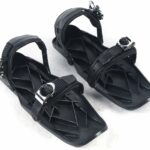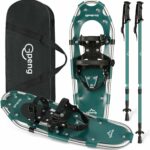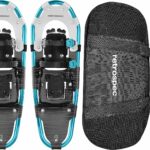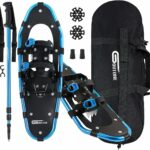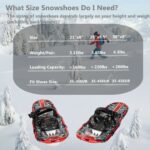Learning to put on GV snowshoes correctly can make a world of difference to your winter adventuring. This article serves as a guide to help ease your way into the snowshoeing world, with suitable allure for both beginners and seasoned snow trekkers. You’ll discover the optimal way to fasten those bindings tightly, arrange your foot placement correctly, and march confidently across that icy terrain. Read on, and see how quickly you can transform your winter hikes into memorable adventures.
Understanding GV Snowshoes
GV Snowshoes is a widely recognized brand offering top-tier snowshoes with a reputation for robust construction and solid efficiency.
What are GV snowshoes?
GV Snowshoes are an outdoor footwear product designed to help you traverse snow-covered landscapes with ease. They distribute your weight over a larger area, preventing you from sinking too deep into the snow. These snowshoes come in different shapes, sizes and components, depending upon your requirements and the terrain you plan to tread.
Importance of choosing right GV snowshoes
Choosing the right GV snowshoes is essential because they are responsible for aiding your overall movements on snow-covered terrains. With the right pair, your weight distribution becomes optimal and helps you navigate effortlessly through deep snow. The wrong size or fit, however, could make treks strenuous and difficult.
Choosing Right Size of GV Snowshoes
Importance of selecting the proper size
Selecting the appropriate size of GV Snowshoes can be the difference between an enjoyable outdoor excursion and an unpleasant one. Getting the right size will not only improve your comfort but also boost your safety as the right size provides better control and balance on slippery, snow-covered terrains.
How to measure for GV snowshoes
This process involves considering your weight, including any load you might carry, and the type of terrain you’ll be exploring. For softer, deeper snow or heavier loads, go for larger snowshoes. For compacted snow or trails, smaller ones are suitable. Be sure to check the manufacturer’s size chart as well for specifics.
Analyzing GV Snowshoes Components
Description of GV snowshoes components
Every pair of GV Snowshoes consists of a frame, decking, a binding system, and crampons. The frame is usually either oval or tear-shaped, made from an alloy or plastic, providing the basic shape and rigidity. The decking material is responsible for its buoyancy in snow while the bindings keep your boots secured to the snowshoes. Lastly, the crampons or cleats underneath provide traction over slippery terrains.
The role of each GV snowshoe component
Each component has a specific role in ensuring safety, efficiency and comfort during your outdoor adventure. The frame and decking together ensure optimal flotation over snow. The bindings keep your feet firmly secured to the snowshoes, enabling precise control while moving. Crampons, on the other hand, offer traction and stability, preventing slips and falls on icy paths.
Importance of Wearing the right gear with GV Snowshoes
Suitable clothing
When snowshoeing, it’s always a good idea to dress in layers. Start with moisture-wicking underwear, add an insulating layer such as fleece or wool, then top it off with water and wind-resistant outerwear. Don’t forget a pair of waterproof gloves and a warm hat or headband.
Suitable footwear
Your footwear should be insulated, waterproof and comfortable, as you’ll be spending much time trekking through the snow. High-quality winter boots are a great choice as they provide both warmth and protection from the elements.
Preparing the GV Snowshoes for Wearing
Checking the condition of GV snowshoes
Before sliding your feet into your GV Snowshoes, it’s crucial to check them for any potential damage, including worn-out bindings or torn decking. Checking the crampons for bent or broken teeth is also important as it can significantly affect your grip on the ice and snow.
Cleaning the snowshoes if necessary
Remove any dirt, ice or snow build-up from your snowshoes. Make sure the bindings and crampon areas are clean and functional. Regular cleaning not only prolongs the lifespan of your snowshoes but also ensures optimal performance.
Putting on GV Snowshoes
Starting with right or left foot
There’s no set rule on whether you should start with the right or left foot when putting on your GV Snowshoes. It’s best to go with whatever feels natural and comfortable.
Attaching front part of the shoe
Position your foot so that the ball of your boot aligns with the pivot point of the snowshoe. Then, secure the front strap of the binding system around your boot, ensuring it’s snug but not too tight.
Fastening heel strap securely
Lastly, fasten the heel strap securely but comfortably around the boot. This should keep your heel from lifting significantly off the snowshoe while allowing for a natural stride.
Testing the Fit of GV Snowshoes
How to check if the GV snowshoes fit well
Once you’ve fastened them, walk around briefly. The snowshoes should feel secure, but you should still have some wiggle room for your toes. Your heel should lift up from the deck while the balls of your feet remain fixed on the snowshoe.
Adjusting snowshoes for comfort
If anything feels uncomfortable during your test-walk or if your toes are scrunched, adjust the bindings. Typically, loosening or tightening the straps can make all the difference.
Walking Techniques with GV Snowshoes
Walking technique on flat terrain
When walking on flat terrain, maintain a slightly wider stance than normal to accommodate the size of the snowshoes. Keep your poles at a 90-degree angle for stability, and slide your snowshoes along the ground.
How to climb and descend hills
For climbing hills, aim to step directly into the snow with your toe to get the best grip. When descending, keep your weight back and make sure your poles are in front of you. Step flat-footed for maximum crampon contact with the ground.
Removing GV Snowshoes
Why you should remove GV snowshoes correctly
Removing your snowshoes correctly is vital to prevent damage to the snowshoes or injury to yourself. Also, careful removal can extend the life of the bindings.
Steps to effectively remove GV snowshoes
First, unfasten the heel strap, then loosen the straps across the front of your boot. Your foot should lift out easily. Be sure to remove any snow or ice before storing your snowshoes.
Maintaining Your GV Snowshoes
How to clean your GV snowshoes
To clean your GV Snowshoes, use lukewarm soapy water and a soft-bristled brush, focusing on removing any dirt or grime from the bindings and crampons. Dry them properly before storing.
Tips for storage and upkeep of GV snowshoes
When storing your GV Snowshoes, keep them in a cool dry place out of direct sunlight. Hanging them up by the frames is a good way to save space. Regular checks for damage, particularly at the start and the end of snow season, can prolong their life and ensuring they’re always ready for your next snowy adventure.
- What Snowboard Bindings Should I Get? - January 23, 2024
- What Size Screws For Snowboard Bindings? - January 23, 2024
- How To Snowmobile On Water? - January 23, 2024





